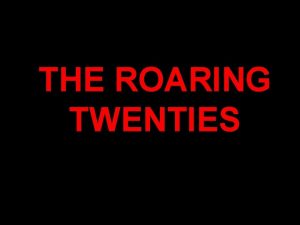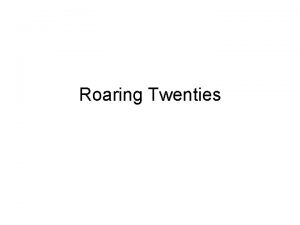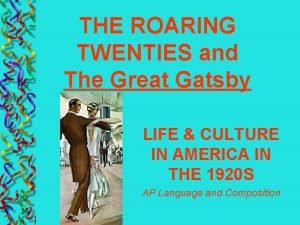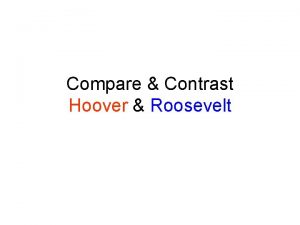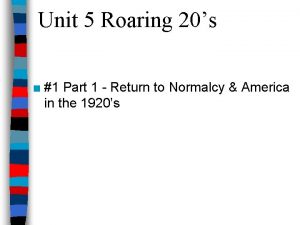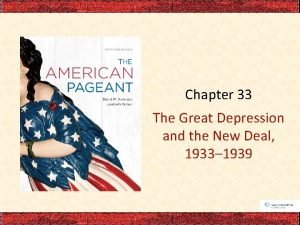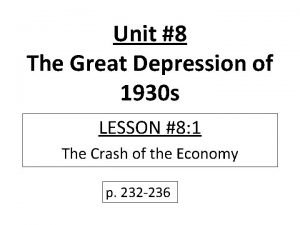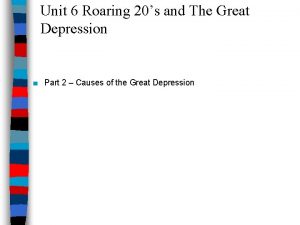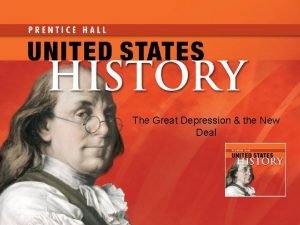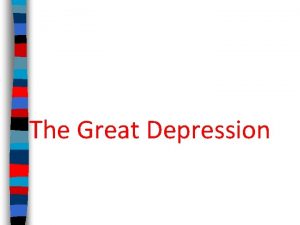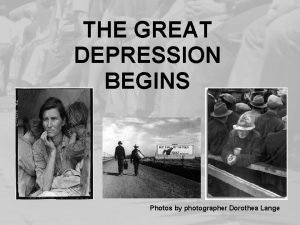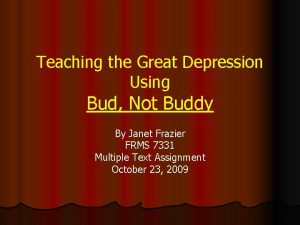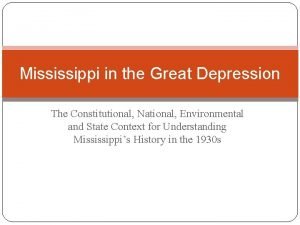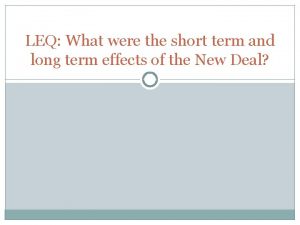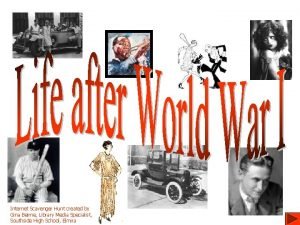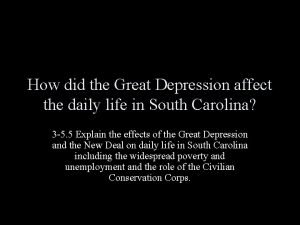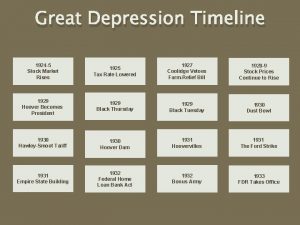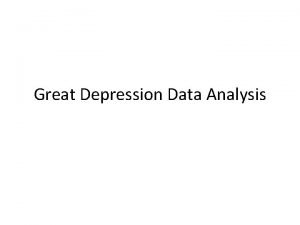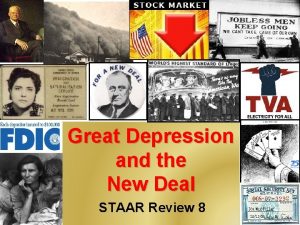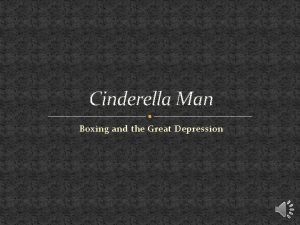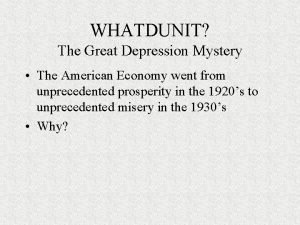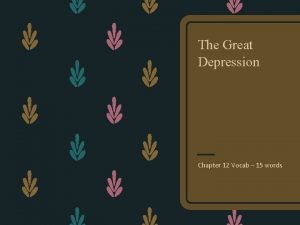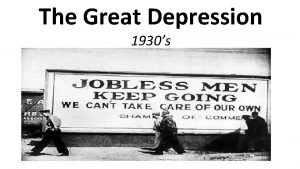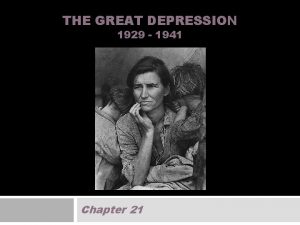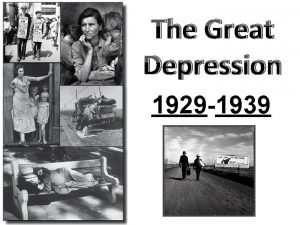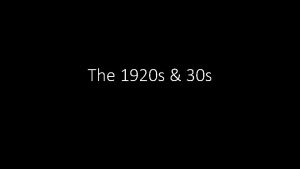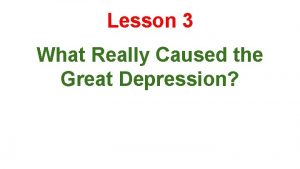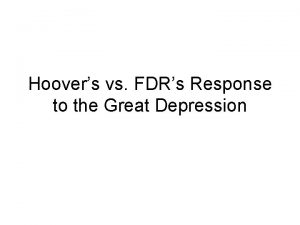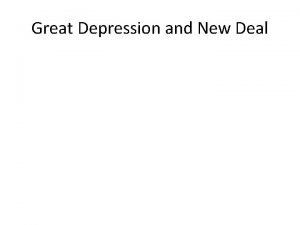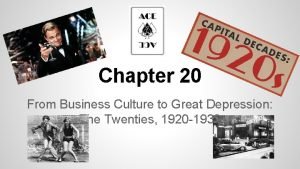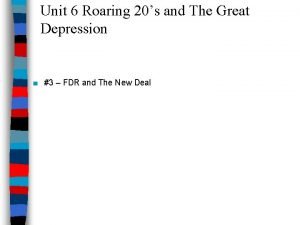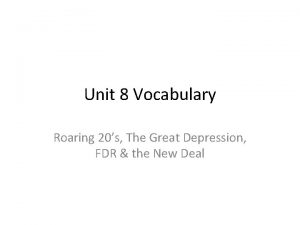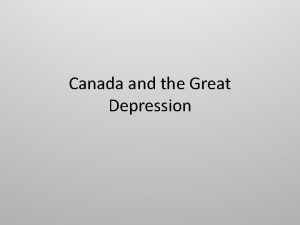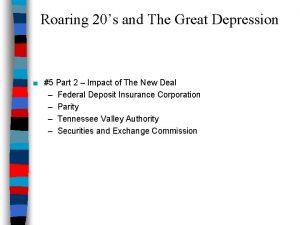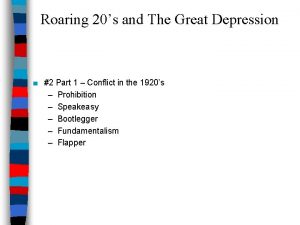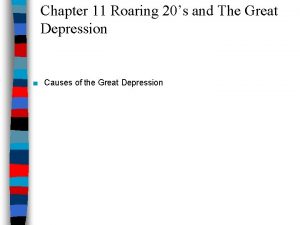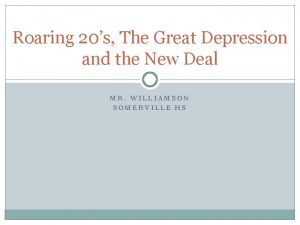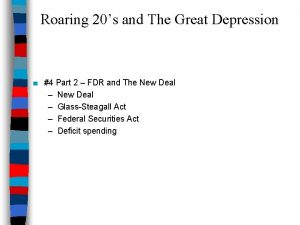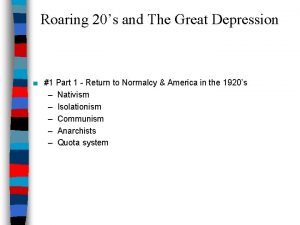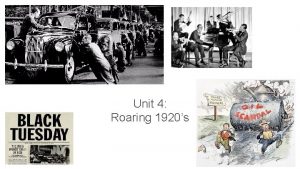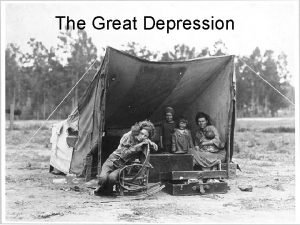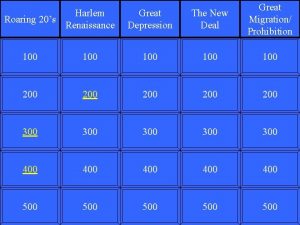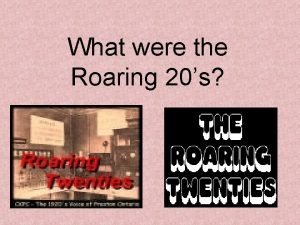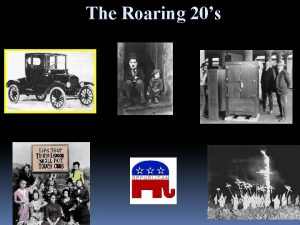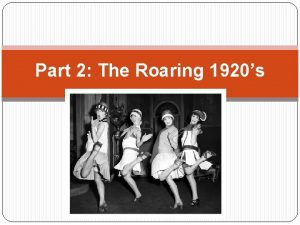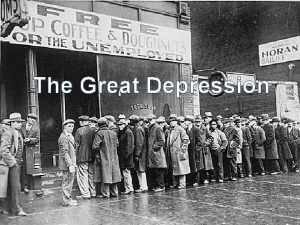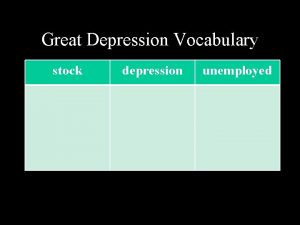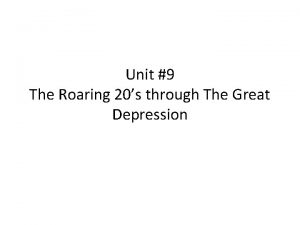Unit 6 Roaring 20s and The Great Depression














































- Slides: 46

Unit 6 Roaring 20’s and The Great Depression ■ Part 2 – Causes of the Great Depression

■ Essential Question: –What were the causes of the Great Depression? ■ Warm-Up Question: –Think about the changes that took place in America in the 1920 s. In what ways were these changes good? Bad?

Causes of the Great Depression ■ The 1920 s were a decade of consumer spending & the economy looked healthy on the surface: –Income did increase in the 1920 s, but there were some severe problems with the U. S. economy –In October 1929, the “Roaring Twenties” came to an end & the Great Depression began…why?

Group Activity: What caused the Great Depression? ■ In teams, determine what factors contributed to the Great Depression: –Examine the documents provided & complete the chart in your notes –After examining all documents, try to group the documents into categories –When finished, create a one sentence thesis that explains why the depression began…be prepared to discuss

Causes of the Great Depression: A Distribution of Wealth in the 1920 s * An income of $2, 500 per year was considered the minimum amount needed for a decent standard of living

Causes of the Great Depression: B

Causes of the Great Depression: C Benefits & Risks of Buying Stock “on Margin”

Causes of the Great Depression: D

Causes of the Great Depression: E Corporate Profits for Coal and Railroad Industries, 1920 -1930 Profits for Railroad Companies Profits for Coal Mining

Causes of the Great Depression: F

Causes of the Great Depression

Causes of the Depression ■ Weak Industries: – Mass-production of consumer goods led to overproduction “Traditional industries” faced new – People did need as competition in not the 1920: many appliances & cars Cars, synthetic clothes, natural gas by the end of the decade (under-consumption) – Railroads, textiles, steel, coal mining, construction were barely profitable

Overproduction of Consumer Goods Too much inventory…Not enough buyers

“Traditional” industries suffered in the 1920 s Corporate Profits for Coal and Railroad Industries, 1920 -1930 Profits for Railroad Companies Profits for Coal Mining

Causes of the Depression ■ Depressed Farming: – The end of WWI led to a decline in demand for agricultural products – Too much food led to a 40% drop in crop prices – Farmers could not pay back loans & many had their farms foreclosed – Some rural banks failed


Causes of the Depression ■ Credit: – Many Americans used easy credit to live beyond their means – By “buying now & paying later, ” Americans generated large debts – As a result, Americans cut back on spending by the end of the decade

Americans bought goods on credit & did not have much in savings accounts

Causes of the Depression ■ Uneven Division of Wealth – Despite rising wages, the gap between the rich & poor grew wider in the 1920 s – 70% of Americans were considered “poor” – Most of the spending in the 1920 s was done by 30% of the population

Distribution of Wealth in the 1920 s * An income of $2, 500 per year was considered the minimum amount needed for a decent standard of living

Causes of the Depression ■ The Stock Market: – In the 1920 s, the stock market soared & people speculated with stocks – Many people borrowed money to pay for stocks, called buying on margin – There was no regulation of the market & some companies altered stock values to raise profits

Buying Stocks on Margin

Causes of the Depression ■ The Stock Market: – On October 29, 1929 (Black Tuesday) the stock market crashed The stock markettocrash – People rushed sell, in October 1929 marked prices plummeted, & the beginning of the investors lost $30 billion “Great Depression” – Speculators who bought on the margin, could not pay off their debts – Many lost their savings

The U. S. stock market had only about 3 million active buyers & sellers but the spillover into the greater economy led to the Great Depression

Causes of the Depression ■ Bank Failures: – After the crash, people tried to withdraw their money from banks – In 1929, 600 banks failed due to lack of funds & the inability to recoup loans – The failure of the banks left many Americans without their life savings

Bank & Business Failures, 1928 -1933

Causes of the Depression ■ Foreign Trade: – Post-war debts in Europe & high protective tariffs in America limited international trade – The Great Depression led to a global depression in Europe, Asia, & Latin America – World trade fell by 40%

A Global Depression

Causes of the Depression ■ Consumer Confidence: – Millions of Americans lost their jobs or took pay cuts to keep jobs – The lack of confidence in the future kept people from spending money – The lack of spending made the depression drag on until the 1940 s

Unemployment & Consumer Spending, 1928 -1933

Effects of the Great Depression ■ The Great Depression led to a collapse of the U. S. financial system – 25, 000 banks & 90, 000 businesses failed by 1933 –Unemployment peaked at 25% –Many Americans lost their homes –America had record poverty & suicide rates; Fathers abandoned families; Healthcare declined –Private charities created soup kitchens & breadlines to help

Soup Kitchens & Breadlines

Mortgage Foreclosures


Poverty in America

The Dust Bowl ■ The effects of the depression were made worse by the Dust Bowl: –Heavy droughts & over-farming in the West destroyed the Plains –In the early 1930 s, windstorms swept away loose soil –Farmers in the Plains left their farms & searched for work or better land in West coast states

The Dust Bowl (1931 -1939) Areas Affected by the Dust Bowl drought “Okies” & “Arkies” worsened the effects of the Depression

Group Activity: ■ In teams, play the role of an economist & try to bring the Great Depression to an end –Examine each of the “Economic Briefing” sheets provided & choose a solution based upon the choices provided –After examining each briefing sheet, choose a presenter & discuss as a class –When finished, examine “Conservative, Liberal, & Radical Solutions” sheet & examine the reading on how President Hoover responded to the Depression

President Hoover’s Response ■ President Herbert Hoover initially rejected bold gov’t action in response the depression: –He tried to reassure Americans that prosperity would return –He called for volunteerism & “rugged individualism”— Americans need to work together to end the depression

President Hoover’s Response ■ As the depression worsened, Hoover called for more gov’t action –The gov’t issued relief checks to help the unemployed –The Reconstruction Finance Corps (RFC) loaned money to failing businesses –Building projects like Hoover Dam ■ These efforts did not end the depression & many citizens lost faith in President Hoover


Employment Agencies & Relief-Check Lines

Americans who lost their homes, lived in shantytowns nicknamed “Hoovervilles”

The March of the Bonus Army ■ Washington DC, 1932 ■ event where thousands of unemployed World War I veterans marched to the capital city. ■ Looking to Congress for an advance on the bonus compensation promised to them


Conclusions ■ The Depression of the 1930 s came as a shock to Americans: –When the stock market crashed in 1929, businesses closed & millions were unemployed –Americans lost faith in Hoover & began looking for new leadership & an more active gov’t to solve their problems
 Roaring 20s were characterized by
Roaring 20s were characterized by Roaring 20s vocabulary
Roaring 20s vocabulary Demobilization and adjustment to peace 1920
Demobilization and adjustment to peace 1920 20s decade fashion
20s decade fashion Roaring twenties great gatsby
Roaring twenties great gatsby Compare and contrast hoover and fdr
Compare and contrast hoover and fdr Organic chemistry (3rd) edition chapter 1 problem 20s
Organic chemistry (3rd) edition chapter 1 problem 20s Fashion in the 20s
Fashion in the 20s The great depression vocabulary
The great depression vocabulary Hardship and suffering lesson 2
Hardship and suffering lesson 2 Pros and cons of the great depression
Pros and cons of the great depression Main idea
Main idea Chapter 33 the great depression and the new deal
Chapter 33 the great depression and the new deal Rarig great depression
Rarig great depression Great depression
Great depression Sec the great depression
Sec the great depression Foreclosure great depression
Foreclosure great depression Five effects of the great depression
Five effects of the great depression Five effects of the great depression
Five effects of the great depression How did the great depression impact the world
How did the great depression impact the world Mein kampf definition ap world history
Mein kampf definition ap world history Bud not buddy great depression
Bud not buddy great depression Pantoum of the great depression
Pantoum of the great depression The great depression summary
The great depression summary Cpi during the great depression
Cpi during the great depression Okies great depression
Okies great depression The great depression leq
The great depression leq Five effects of the great depression
Five effects of the great depression How did the great depression affect south carolina
How did the great depression affect south carolina Great depression timeline
Great depression timeline Great depression causes
Great depression causes Brief summary of the great depression
Brief summary of the great depression Hoovervilles
Hoovervilles Birth rate during the great depression
Birth rate during the great depression Overspeculation great depression
Overspeculation great depression Great depression vocab
Great depression vocab Great depression vocabulary words
Great depression vocabulary words Great depression bank runs
Great depression bank runs Http://www.history.com/topics/great-depression
Http://www.history.com/topics/great-depression Black tuesday great depression
Black tuesday great depression Hawley-smoot tariff great depression
Hawley-smoot tariff great depression Stock market cartoon
Stock market cartoon Great depression budget activity
Great depression budget activity 1932 electoral map
1932 electoral map Hoovervilles great depression
Hoovervilles great depression Laissez faire great depression
Laissez faire great depression From business culture to great depression
From business culture to great depression

